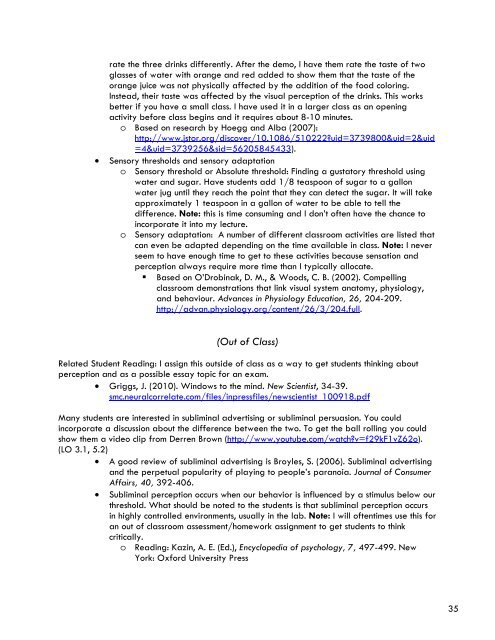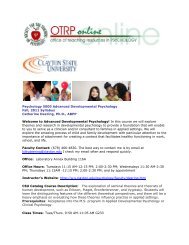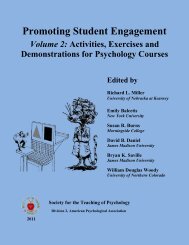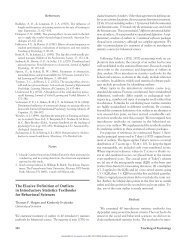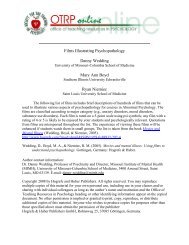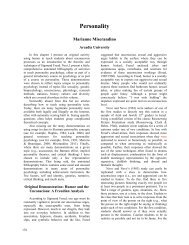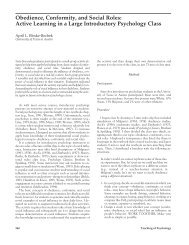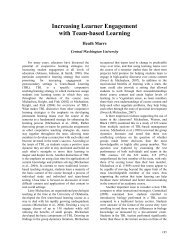INTRODUCTORY PSYCHOLOGY TEACHING PRIMER Early Career ...
INTRODUCTORY PSYCHOLOGY TEACHING PRIMER Early Career ...
INTRODUCTORY PSYCHOLOGY TEACHING PRIMER Early Career ...
You also want an ePaper? Increase the reach of your titles
YUMPU automatically turns print PDFs into web optimized ePapers that Google loves.
ate the three drinks differently. After the demo, I have them rate the taste of two<br />
glasses of water with orange and red added to show them that the taste of the<br />
orange juice was not physically affected by the addition of the food coloring.<br />
Instead, their taste was affected by the visual perception of the drinks. This works<br />
better if you have a small class. I have used it in a larger class as an opening<br />
activity before class begins and it requires about 8-10 minutes.<br />
o Based on research by Hoegg and Alba (2007):<br />
http://www.jstor.org/discover/10.1086/510222?uid=3739800&uid=2&uid<br />
=4&uid=3739256&sid=56205845433).<br />
• Sensory thresholds and sensory adaptation<br />
o Sensory threshold or Absolute threshold: Finding a gustatory threshold using<br />
water and sugar. Have students add 1/8 teaspoon of sugar to a gallon<br />
water jug until they reach the point that they can detect the sugar. It will take<br />
approximately 1 teaspoon in a gallon of water to be able to tell the<br />
difference. Note: this is time consuming and I don’t often have the chance to<br />
incorporate it into my lecture.<br />
o Sensory adaptation: A number of different classroom activities are listed that<br />
can even be adapted depending on the time available in class. Note: I never<br />
seem to have enough time to get to these activities because sensation and<br />
perception always require more time than I typically allocate.<br />
Based on O’Drobinak, D. M., & Woods, C. B. (2002). Compelling<br />
classroom demonstrations that link visual system anatomy, physiology,<br />
and behaviour. Advances in Physiology Education, 26, 204-209.<br />
http://advan.physiology.org/content/26/3/204.full.<br />
(Out of Class)<br />
Related Student Reading: I assign this outside of class as a way to get students thinking about<br />
perception and as a possible essay topic for an exam.<br />
• Griggs, J. (2010). Windows to the mind. New Scientist, 34-39.<br />
smc.neuralcorrelate.com/files/inpressfiles/newscientist_100918.pdf<br />
Many students are interested in subliminal advertising or subliminal persuasion. You could<br />
incorporate a discussion about the difference between the two. To get the ball rolling you could<br />
show them a video clip from Derren Brown (http://www.youtube.com/watch?v=f29kF1vZ62o).<br />
(LO 3.1, 5.2)<br />
• A good review of subliminal advertising is Broyles, S. (2006). Subliminal advertising<br />
and the perpetual popularity of playing to people’s paranoia. Journal of Consumer<br />
Affairs, 40, 392-406.<br />
• Subliminal perception occurs when our behavior is influenced by a stimulus below our<br />
threshold. What should be noted to the students is that subliminal perception occurs<br />
in highly controlled environments, usually in the lab. Note: I will oftentimes use this for<br />
an out of classroom assessment/homework assignment to get students to think<br />
critically.<br />
o Reading: Kazin, A. E. (Ed.), Encyclopedia of psychology, 7, 497-499. New<br />
York: Oxford University Press<br />
35


